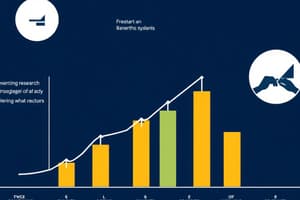Podcast
Questions and Answers
What defines data in the context of data management?
What defines data in the context of data management?
- Data are always numerical facts only.
- Data are raw facts that require organization to become useful. (correct)
- Data can never be qualitative.
- Data management is irrelevant to analyzing results.
Which of the following is NOT a component of data management?
Which of the following is NOT a component of data management?
- Preparing data for analysis
- Documenting and archiving data
- Checking and correcting raw data
- Storing data permanently without review (correct)
What is a primary advantage of conducting a sample survey compared to a census?
What is a primary advantage of conducting a sample survey compared to a census?
- It lowers costs and speeds up data collection. (correct)
- It is always more accurate than a census.
- It eliminates the need for data management.
- It requires a larger population.
When is an experiment most appropriate?
When is an experiment most appropriate?
What is a characteristic of observation studies?
What is a characteristic of observation studies?
What is the primary purpose of data management concerning future studies?
What is the primary purpose of data management concerning future studies?
Which of the following statements is true about census data collection?
Which of the following statements is true about census data collection?
Which of the following is a disadvantage of using a census?
Which of the following is a disadvantage of using a census?
What is a characteristic of systematic sampling?
What is a characteristic of systematic sampling?
What is a main drawback of systematic sampling?
What is a main drawback of systematic sampling?
Why might stratified sampling be used instead of simple random sampling?
Why might stratified sampling be used instead of simple random sampling?
What changes in the selection probability occur in systematic sampling?
What changes in the selection probability occur in systematic sampling?
In stratified sampling, how is the population organized?
In stratified sampling, how is the population organized?
What is the primary goal of creating strata in stratified sampling?
What is the primary goal of creating strata in stratified sampling?
How can systematic sampling help with databases?
How can systematic sampling help with databases?
What is a potential limitation of using systematic sampling in a population with a defined pattern?
What is a potential limitation of using systematic sampling in a population with a defined pattern?
What is the primary purpose of using a chi-square goodness of fit test?
What is the primary purpose of using a chi-square goodness of fit test?
What design is characterized by measurements taken on the same subject before and after treatment?
What design is characterized by measurements taken on the same subject before and after treatment?
Which of the following is NOT an assumption of the chi-square test?
Which of the following is NOT an assumption of the chi-square test?
In a randomized block design, what is the function of the blocks?
In a randomized block design, what is the function of the blocks?
What does a very small chi-square test statistic indicate?
What does a very small chi-square test statistic indicate?
What is the main difference between the chi-square test for independence and the goodness of fit test?
What is the main difference between the chi-square test for independence and the goodness of fit test?
In completely randomized designs, how are levels of the primary factor assigned?
In completely randomized designs, how are levels of the primary factor assigned?
Which of the following best describes the observations required for the chi-square test?
Which of the following best describes the observations required for the chi-square test?
Which condition is NOT crucial for effective stratified sampling?
Which condition is NOT crucial for effective stratified sampling?
What is a primary benefit of cluster sampling?
What is a primary benefit of cluster sampling?
What is matched random sampling specifically designed to address?
What is matched random sampling specifically designed to address?
What is a potential drawback of cluster sampling?
What is a potential drawback of cluster sampling?
In a well-designed experiment, why is it essential to compare new treatments with standard treatments?
In a well-designed experiment, why is it essential to compare new treatments with standard treatments?
Which aspect does NOT contribute to the effectiveness of stratified sampling?
Which aspect does NOT contribute to the effectiveness of stratified sampling?
Which characteristic is essential for a well-conducted statistical experiment?
Which characteristic is essential for a well-conducted statistical experiment?
What is one consequence of increasing variability among clusters in cluster sampling?
What is one consequence of increasing variability among clusters in cluster sampling?
What is a confounding variable?
What is a confounding variable?
What is the primary purpose of blinding in an experiment?
What is the primary purpose of blinding in an experiment?
Why is it incorrect to conclude a causal relationship from the correlation between ice cream sales and drowning deaths?
Why is it incorrect to conclude a causal relationship from the correlation between ice cream sales and drowning deaths?
What is a placebo effect?
What is a placebo effect?
What does blocking aim to accomplish in an experiment?
What does blocking aim to accomplish in an experiment?
In a completely randomized design, what is primarily studied?
In a completely randomized design, what is primarily studied?
Which of the following best describes a randomized block design?
Which of the following best describes a randomized block design?
What is the purpose of a control group in an experiment?
What is the purpose of a control group in an experiment?
What is the calculated value of the chi-squared statistic?
What is the calculated value of the chi-squared statistic?
What is the significance level ($\alpha$) used in this analysis?
What is the significance level ($\alpha$) used in this analysis?
What is the critical value for a chi-squared test with 2 degrees of freedom at a significance level of 0.10?
What is the critical value for a chi-squared test with 2 degrees of freedom at a significance level of 0.10?
Why can the null hypothesis ($H_0$) be rejected based on the calculated chi-squared statistic?
Why can the null hypothesis ($H_0$) be rejected based on the calculated chi-squared statistic?
In the chi-squared calculation, what does the term $(O - E)$ represent?
In the chi-squared calculation, what does the term $(O - E)$ represent?
How is the value of $E$ (expected frequency) determined for each cell in the table?
How is the value of $E$ (expected frequency) determined for each cell in the table?
Which of the following describes the result of the statistical test indicated in the content?
Which of the following describes the result of the statistical test indicated in the content?
What is the purpose of calculating $(O - E)^2 / E$ for each cell?
What is the purpose of calculating $(O - E)^2 / E$ for each cell?
Flashcards
Data Management
Data Management
The process of organizing, storing, and using data effectively.
Data
Data
Raw information or facts that can become useful when organized.
Census
Census
Gathering data from every member of a population.
Sample Survey
Sample Survey
Signup and view all the flashcards
Experiment
Experiment
Signup and view all the flashcards
Observation Study
Observation Study
Signup and view all the flashcards
Data Quality
Data Quality
Signup and view all the flashcards
Replication
Replication
Signup and view all the flashcards
Systematic Sampling
Systematic Sampling
Signup and view all the flashcards
Strata
Strata
Signup and view all the flashcards
Probability Sampling
Probability Sampling
Signup and view all the flashcards
SRS
SRS
Signup and view all the flashcards
Periodicities
Periodicities
Signup and view all the flashcards
Stratified Sampling
Stratified Sampling
Signup and view all the flashcards
Different selection probabilities
Different selection probabilities
Signup and view all the flashcards
Sampling Frame
Sampling Frame
Signup and view all the flashcards
Stratified Sampling
Stratified Sampling
Signup and view all the flashcards
Strata Variability
Strata Variability
Signup and view all the flashcards
Cluster Sampling
Cluster Sampling
Signup and view all the flashcards
Matched Random Sampling
Matched Random Sampling
Signup and view all the flashcards
Well-Designed Experiment
Well-Designed Experiment
Signup and view all the flashcards
Treatment Effects
Treatment Effects
Signup and view all the flashcards
Standard Treatment
Standard Treatment
Signup and view all the flashcards
Experimental Variability
Experimental Variability
Signup and view all the flashcards
Confounding Variable
Confounding Variable
Signup and view all the flashcards
Placebo Effect
Placebo Effect
Signup and view all the flashcards
Blinding
Blinding
Signup and view all the flashcards
Blocking
Blocking
Signup and view all the flashcards
Completely Randomized Design
Completely Randomized Design
Signup and view all the flashcards
Type I Error
Type I Error
Signup and view all the flashcards
Independent Variable
Independent Variable
Signup and view all the flashcards
Dependent Variable
Dependent Variable
Signup and view all the flashcards
Completely Randomized Design
Completely Randomized Design
Signup and view all the flashcards
Randomized Block Design
Randomized Block Design
Signup and view all the flashcards
Matched Pairs Design
Matched Pairs Design
Signup and view all the flashcards
Chi-Square Test
Chi-Square Test
Signup and view all the flashcards
Goodness-of-Fit Test
Goodness-of-Fit Test
Signup and view all the flashcards
Test of Independence
Test of Independence
Signup and view all the flashcards
Chi-Square Statistic
Chi-Square Statistic
Signup and view all the flashcards
Assumptions of Chi-Square
Assumptions of Chi-Square
Signup and view all the flashcards
Test Statistic Calculation (𝜒²)
Test Statistic Calculation (𝜒²)
Signup and view all the flashcards
Observed Frequency (O)
Observed Frequency (O)
Signup and view all the flashcards
Expected Frequency (E)
Expected Frequency (E)
Signup and view all the flashcards
𝜒²
𝜒²
Signup and view all the flashcards
Degrees of Freedom
Degrees of Freedom
Signup and view all the flashcards
Critical Value
Critical Value
Signup and view all the flashcards
Null Hypothesis (H₀)
Null Hypothesis (H₀)
Signup and view all the flashcards
Rejection of H₀
Rejection of H₀
Signup and view all the flashcards
Study Notes
Data Management
- Data are raw information or facts that become useful information when organized meaningfully.
- Data can be qualitative or quantitative.
- Data Management involves looking after and processing data.
- Tasks include: looking after field data sheets, checking and correcting raw data, preparing data for analysis, documenting and archiving data and metadata.
Importance of Data Management
- Ensures data for analysis is high quality, leading to correct conclusions.
- Allows future use of data and efficient integration with other studies.
- Improves processing efficiency, data quality, and the meaningfulness of data.
Planning and Conducting an Experiment or Study
Methods of Data Collection
- Census: Systematically collecting data from all members of a population. Rarely used due to high cost and dynamic populations.
- Sample Survey: Selecting a subset of a population to gain knowledge about the entire population. Cost-effective, faster, and allows for better data accuracy and quality.
- Experiment: Used when controlled variables (e.g., treatments) are studied to see their effect on other observed variables (e.g., patient health). Requires replication.
- Observation Study: Used when there are no controlled variables and replication is impossible. Often uses surveys to observe correlations, like between smoking and lung cancer.
Planning and Conducting Surveys
- Well-designed Surveys: Surveys should accurately represent the population.
- Probabilistic Methods: Incorporate chance (like random number generators) to select participants to ensure accurate representation.
- Neutral Wording: Questions should be worded neutrally to prevent biased responses.
- Sampling Methods: Methods include non-probability and probability sampling.
- Non-probability sampling: Elements may have no chance of selection or probability of selection is unknown (e.g. convenience sampling where the first person who answers the door is selected).
- Probability Sampling: Methods where the probability of selecting each element is known (e.g. Simple Random Sampling (SRS) where every member has an equal chance). Common probability sampling methods include SRS, Systematic Sampling, Stratified Sampling, and Cluster Sampling.
Planning and Conducting Experiments
- Characteristics: Include stating research purpose, estimation of treatment effects, alternative hypotheses, comparison of new treatments to standard treatments, experimental design (blocking), examination of results to suggest further research, and documenting results.
- Randomization: Essential for minimizing bias by randomly assigning treatments to experimental units.
- Replication: Repeating measurements and observations helps to reduce variability.
- Control Groups: A control group, that doesn't receive the treatment, is used for comparison.
- Experimental Units: The subjects or items for which treatment is tested.
- Blinding: (in experiments) Where participants and/or researchers are kept ignorant of group assignments to eliminate observer bias.
- Placebos: A placebo is a treatment that seems real but has no active ingredient.
- Blocking: Experimental units are put in groups that are similar so that there is no bias in variables that are unrelated to the treatment
Data Analysis Methods
Chi-Square Tests
- Goodness-of-Fit Test: See if a sample matches a population.
- Test of Independence: Used to evaluate if two variables are related or independent of each other.
Studying That Suits You
Use AI to generate personalized quizzes and flashcards to suit your learning preferences.




